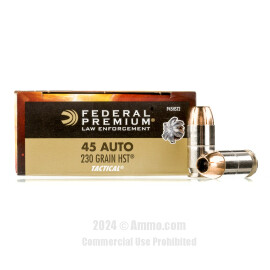
45 ACP Ammo For Sale
History of 45 ACP Ammo
The .45 ACP, developed by John Moses Browning in 1905, is a cornerstone of American ammunition known for its power and reliability. It offers excellent stopping power and accuracy, making it ideal for personal protection, law enforcement, and competitive shooting. Originally designed to meet the U.S. Cavalry's need for a more effective round, it became the official sidearm of the U.S. Armed Forces in 1911 with the M1911 pistol. Favored by units like the FBI's Hostage Rescue Team and LAPD SWAT, the .45 ACP's versatility and effectiveness continue to make it a trusted choice over a century later.
What are the most popular .45 ACP brands you sell?
- Federal .45 ACP Ammo
- Fiocchi .45 ACP Ammo
- Hornady .45 ACP Ammo
- PMC .45 ACP Ammo
- Remington .45 ACP Ammo
- Sellier & Bellot .45 ACP Ammo
- Blazer Brass .45 ACP Ammo
You can filter our entire selection using the left sidebar to see which brands we currently have in-stock and available using the Manufacturers filter. You can also filter by attributes such as Bullet Type, Bullet Weight, Casing Type, and Primer Type to find what you need.
Best 45 ACP Ammo for Specific Uses
| Use Case | Details |
|---|---|
| Best .45 ACP Hollow Points | Best Overall: Sellier & Bellot XRG Defense 165 Grain SCHP. Runner-Up: Speer Gold Dot 185 Grain JHP. |
| Best .45 ACP Ammo for Target | Best Overall: Speer Lawman 230-grain TMJ. Runner-Up: Federal American Eagle 230 gr FMJ. |
| Best .45 ACP Ammo for Law Enforcement | Best Overall: Speer Gold Dot 230 Grain JHP. Runner-Up: Federal Law Enforcement HST 230 Grain JHP. |
| Ammo for 1911 .45 | Best Overall: Hornady Critical Defense 185 Grain FTX JHP. Runner-Up: Federal Hydra-Shok Deep 210 Grain JHP. |
| Best .45 ACP for Bear Defense | Best Overall: Federal American Eagle 230gr FMJ. Runner-Up: Fiocchi 230gr FMJ. |
You can also check out our in-depth look at 45 ACP ballistics from all of the popular ammo manufacturers if you're in search of ballistics data for your favorite factory 45 ACP load.
Customer Reviews
-
Jack said:
This ammo is awesome! Great quality. And the price is on target.
-
Tyler said:
The ammo shoots perfectly out of my picky 1911. I had zero malfunctions out of 500 rounds shot. Fiocchi ammo gave me an average of one malfunction / 50 rounds shot. My only gripes are that the bullets look a little dirty, which of course had no issue with performance. And mostly the only thing I didn't like was that the tray the bullets come in is made out of Styrofoam so it leaves little foam bits all over the counter at the range.... All in all I would buy again.
-
Ed said:
1 particular 1911 it’s flawless where other brands of ammo it’ll stovepipe..However it’s good in all my 1911s..
-
ElHalcon said:
Ammo acted and performed as I knew it would since I have used it before
-
Kbob said:
No jamming and reasonable priced.
-
eeffoc said:
My recent purchase from ammo.com met my expectations I enjoyed shooting it, and have no problems with the price. I will shop ammo.com again
-
SIW said:
I've sent a quite a few hundred down range with my 1911, and my SA XDM 3.8. Not one issue.
-
Harry said:
So far only fired 100 rounds. Had one stovepipe in first 50, and two stovepipes in second 50. The pistol is 50 years old and in near-perfect condition. I normally do not get more than 1 hung case in 500 or more rounds, much of it Blazer Brass purchased locally. As I get more experience with this lot of Blazer Brass, I'll try to update my opinion.
-
Ammodude4u2 said:
A pleasant surprise for quality in value provided and accuracy. Performed well in 3 different firearms ( 2 pistols, 1 carbine style rifle) . Had previous excellent experience with various loads of .22 caliber offerings from this manufacturer.
-
Lou said:
The bullet design seems like a good concept, the ballistic gel tests that I've seen regarding the Honey Badger design were impressive. The concern: The very first round I tried to feed into my Dan Wesson 1911 jammed solid on the feed ramp. Subsequent tries had the same result and the cartridge suffered ~1mm of bullet setback. That particular cartridge didn't appear any different than the others. I cycled other rounds from the same box several times without issue or bullet setback. Maybe the first round I tried was defective. The next time I go to the range I'll try them out.

















